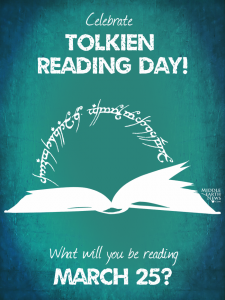
With Amazon announcing that their up-coming Tolkien-inspired TV show will include Middle-earth’s Second Age, we thought it would be a great time to focus on the mysteries surrounding the era for 2019’s Tolkien Reading Day. It is an era that is perhaps a little over looked as it has little material written about it in comparison to the First or Third age. Still, a lot happen during the 3,441 years that it encompassed. It was this age that saw the rise and destruction of the island of Numenor, the forging of the rings of power, and the War of the Last Alliance.
The Second Age began with conclusion of the War of Wrath in which Morgoth was finally imprisoned and the lands of Beleriand, where many of the events of the Silmarillion had taken place, were lost in a great cataclysm. It could be considered something of a dark age, where most of the glories of the previous age had perished. The great citidales built by the Noldor had been lost under the waves, although by then most had already been overrun by the armies of Orcs, Balrogs, and Dragons. Many of the peoples who struggled heroically against Morgoth for long years were war weary and all but beaten by the time the Valar arrived and finally overthrew Morgoth.
To some extent civilization had to begin again. The Edain, those houses of mortal men who were faithful foes of Morgoth, had lost nearly everything. The Noldor had likewise born great losses and many chose to return to Valinor once their exile had been lifted. Those who stayed went on to create the realm of Lindon, where Gil-galad ruled, as well as Eregion where most of the rings of power were forged. Meanwhile the isle of Númenor was created by the Valar and the Edain were guided there where in time they would grow into a mighty people.
The first few centuries of the second age would be peaceful. No doubt there would have been a good deal of rebuilding after the great cataclysm of the First Age. Still, not all of Morgoth’s servants had perished. It was in this age that Sauron came into his own as the great foe of the free peoples. In those days, he was still able to appear as a fair and noble lord and was able to deceive both elves and men for many years, hiding his true intentions.
Sauron was able to deceive the elves of Eregion and play on their desire to both dwell in Middle-earth, and match or surpass the the bliss of Valinor. So they allowed Sauron to guide their labors and ultimately ensnare them when he forged the one ring at Mount Doom, around the year 1600 S.A. This would lead to the War of the Elves and Sauron, which in a sense was the first war of the ring. Eregion was destroyed, and Celebrimbor who forged the elven rings was killed. Ultimately Sauron would be dealt a defeat by Gil-Galad with the aid of the Númenoreans. Sauron had suffered a major setback, yet was able to rebuild his power.
Centuries later, he would be able to finish the corruption of the once noble Númenories, who after many years had become very powerful and proud. Eventually, this would lead to the downfall of Númenor and the destruction of the entire island and most of the Númenoreans with it.
This could be argued as one of Sauron’s great and terrible accomplishments. For, while the Númenorians may have become corrupt on their own, perhaps they would not have fully defied the Valar without the additional influence of Sauron. Truely, it must have been spectacular when the Númenorian fleet, led by the proud and arrogant king Al-Pharazôn arrived on the shores of Middle-earth and seemingly brought a captive and humbled Sauron back to Númenor. We must wonder though, who had ultimately won the victory. For Sauron had the one ring with him at that time which certainly aided him further corrupting the Númenoreans and convincing Al-Pharazôn to try to conquer Valinor itself. It was in response to this invasion that Númenor was ultimately destroyed. One small consolation was that Sauron was in Númenor during its destruction, and it is there he lost forever his ability to take on a shape that appeared fair to others.
After the downfall of Númenor, hostilities resumed soon thereafter and culminated in the war of the Last Alliance and the defeat of Sauron that ushered in the beginning of the Third Age.
Suffice to say, the Second Age of Middle-earth was quite eventful. There is certainly a lot for Amazon’s upcoming series to draw on for inspiration. Fortunately, if you are not content to wait for whatever Amazon may have planned, you can find most of the events and deeds discussed here in the last chapters of The Silmarillion, namely the Alkallabeth and Of the Rings of Power and the Third Age. Additional information can also be found in the Appendices of the Lord of the Rings Trilogy.
No matter which of Tolkien’s work you read, let us know in the comment section below.
Happy reading!


